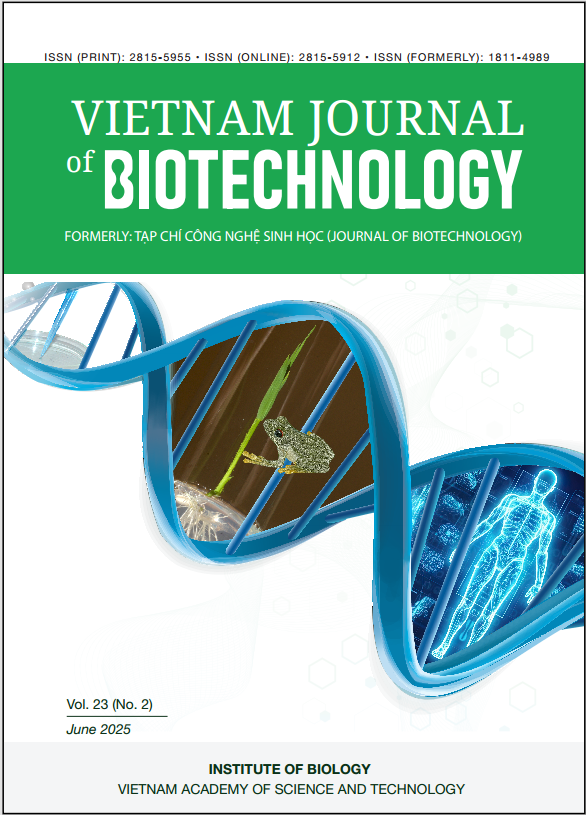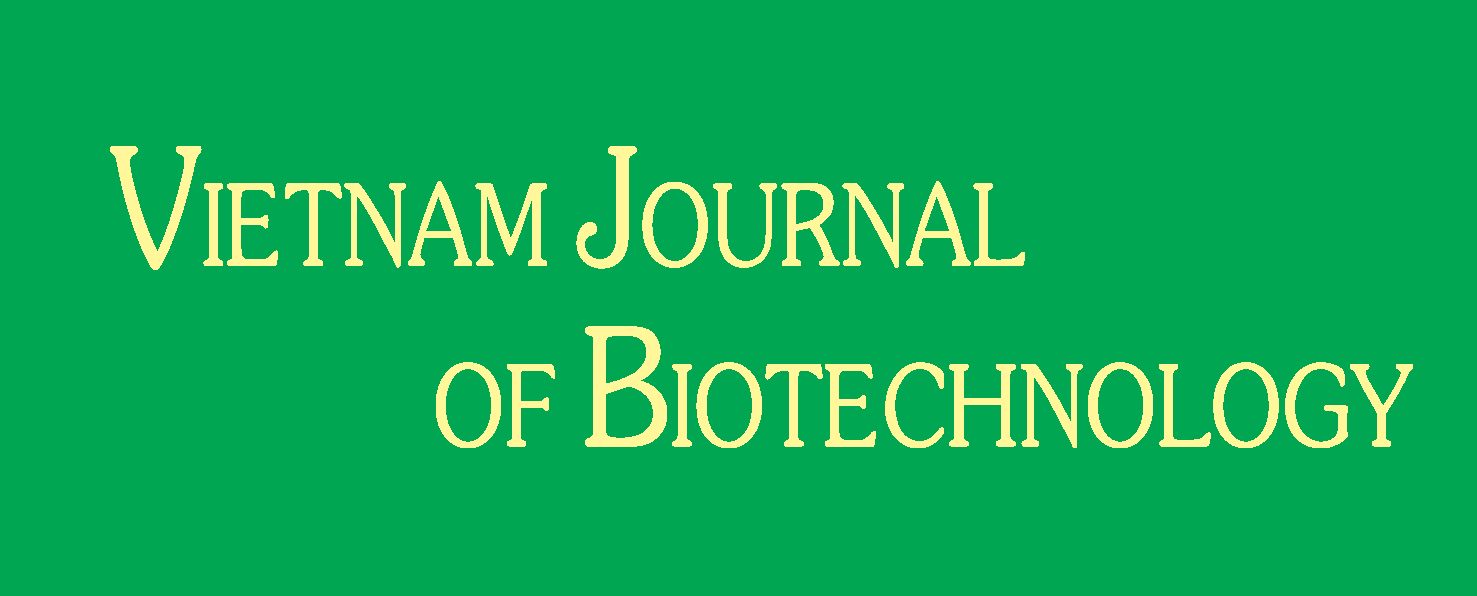Physiological and biochemical characteristics and identification of actinomycete strains isolated from soil samples in Hanoi
Author affiliations
DOI:
https://doi.org/10.15625/vjbt-22858Keywords:
Actinomycetes, antibacteria, isolation, natural product, StreptomycesAbstract
Actinomycetes are a rich source of natural compounds with diverse biological activities. In this study, the actinomycete strain Streptomyces sp. CH8.1 was identified as Streptomyces virginiae through 16S rDNA sequence analysis, alongside the determination of its physiological and biochemical characteristics. Strain CH8.1 demonstrated robust growth on media typical for actinomycetes and could utilize most common nitrogen and carbon sources, including sucrose, maltose, lactose, mannitol, galactose, xylose, cellobiose, glycerin, raffinose, tyrosine, tryptone, peptone, and certain ammonium salts. CH8.1 exhibited antimicrobial activity against both Gram-positive and Gram-negative bacteria, including Staphylococcus aureus CCARM 3640 (MIC of 32 µg/mL), Salmonella enterica ATCC 14028 (MIC of 16 µg/mL), Kocuria rhizophila NBRC 12708 (MIC of 32 µg/mL), Bacillus subtilis VTCC 6633 (MIC of 8 µg/mL), Escherichia coli ATCC 25922 (MIC of 32 µg/mL), and Vibrio sp. (MIC of 16 µg/mL). The R2YE medium was identified as the most suitable for producing antimicrobial compounds. And the CH8.1 strain was demonstrated to contain the type II PKS gene cluster, while lacking the type I PKS gene cluster.
Downloads
References
Al-Dhabi, N.A., Esmail, G.A., Ghilan, A.M., Arasu, M.V., Duraipandiyan, V. and Ponmurugan, K. (2020). Chemical constituents of Streptomyces sp. strain Al-Dhabi-97 isolated from the marine region of Saudi Arabia with antibacterial and anticancer properties. Journal of Infection and Public Health, 13(2), 235–243. http://doi.org/10.1016/j.jiph.2019.09.004.
Ayuso-Sacido A. and O. Genilloud. (2005). New PCR primers forthe screening of NRPS and PKS-I systems in actinomycetes: detection and distribution of these biosynthetic gene sequences in majortaxonomic groups. Microbial Ecology, 49(1): 10–24. http://doi.org/10.1007/s00248-004-0249-6
Chater, K.F. (2016). Recent advances in understanding Streptomyces. F1000Research, 5, 2795. http://doi.org/10.12688/f1000research.9534.1.
Gopalakrishnan, S., Srinivas, V. and Prasanna, S. L. (2020). Streptomyces, in beneficial microbes in agro-ecology. Elsevier. p. 55-71.
Joshi, M.V., Bignell, D. R., Johnson, E. G., Sparks, J. P., Gibson, D. M. and Loria, R. (2007)., The AraC/XylS regulator TxtR modulates thaxtomin biosynthesis and virulence in Streptomyces scabies. Molecular microbiology, 66(3): 633-642. http://doi.org/10.1111/j.1365-2958.2007.05942.x
Kofteridis, D. P., Maraki, S., Scoulica, E., Tsioutis, C., Maltezakis, G., & Gikas, A. (2007). Streptomyces pneumonia in an immunocompetent patient: a case report and literature review. Diagnostic microbiology and infectious disease, 59(4): 459–462. http://doi.org/10.1016/j.diagmicrobio.2007.06.009.
Lambert, D. H. and Loria, R. (1989). Streptomyces scabies sp. nov., nom. rev. International Journal of Systematic and Evolutionary Microbiology, 39(4): 387-392. http://doi.org/10.1099/00207713-39-4-387
Metsä-Ketelä, M., Salo, V., Halo, L., Hautala, A., Hakala, J., Mäntsälä, P. and Ylihonko, K. (1999). An efficient approach for screening minimal PKS genes from Streptomyces. FEMS Microbiology Letters, 180(1):1-6. http://doi.org/10.1111/j.1574-6968.1999.tb08770.x
Minh, L. T. H., Quyên, V. T., Anh, N. M., Hương, Đoàn T. M., Murphy, B. T., Minh, C. V., & Cường, P. V. (2016). Isolation, screening and identification of microorganisms having antimicrobial activity isolated from samples collected on seabed of Northeast Vietnam. Vietnam Journal of Biotechnology, 14(3), 539–547. https://doi.org/10.15625/1811-4989/14/3/9871
Nonomura, H. (1974). Key for classification and identification of 458 species of the Streptomycetes included in ISP. Journal of Fermentation Technology, 52: 78-92
Olanrewaju, O. S. and Babalola, O. O. (2019). Streptomyces: implications and interactions in plant growth promotion. Applied Microbiology and Biotechnology, 103(3): 1179-1188. http://doi.org/10.1007/s00253-018-09577-y
Sambrook, J. (1989). Molecular cloning: a laboratory manual. Cold Spring Habor Laboratory.
Seipke, R. F., Kaltenpoth, M., & Hutchings, M. I. (2012). Streptomyces as symbionts: an emerging and widespread theme? FEMS Microbiology Reviews, 36(4): 862-876. http://doi.org/10.1111/j.1574-6976.2011.00313.x
Shirling, E. B. and Gottlieb, D. (1966). Methods for characterization of Streptomyces species. International Journal of Systematic and Evolutionary Microbiology, 16(3): 313-340. http://doi.org/10.1099/00207713-16-3-313
Tresner, H. D. and Backus, E. J. (1963). System of color wheels for streptomycete taxonomy. Applied microbiology, 11(4): 335-338.
Trinh, P. T. H., Ngoc, N. T. D., Tien, P. Q., Hung, L. D., Trang, V. T. D., Hang, C. T. T., … Ly, B. M. (2016). Antibacterial activity of marine bacteria associated with sponges from Phu Quoc island in Vietnam. Vietnam Journal of Biotechnology, 14(1), 181–190. https://doi.org/10.15625/1811-4989/14/1/9308
Ventura, M., Canchaya, C., Tauch, A., Chandra, G., Fitzgerald, G. F., Chater, K. F., & van Sinderen, D. (2007). Genomics of Actinobacteria: tracing the evolutionary history of an ancient phylum. Microbiology and Molecular Biology Reviews, 71(3): 495-548. http://doi.org/10.1128/MMBR.00005-07
Wood, W. A. and Krieg, N. R. (Eds.). (1989). Methods for general and molecular bacteriology. American Society for Microbiology.







